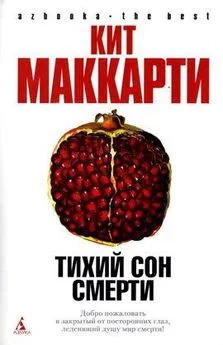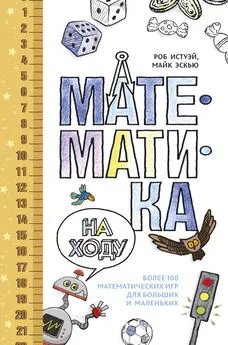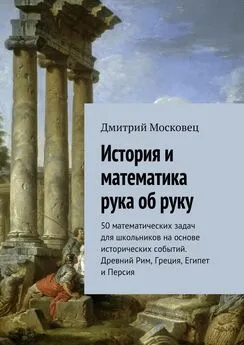Кит Йейтс - Математика жизни и смерти. 7 математических принципов, формирующих нашу жизнь
- Название:Математика жизни и смерти. 7 математических принципов, формирующих нашу жизнь
- Автор:
- Жанр:
- Издательство:неизвестно
- Год:2019
- ISBN:978-5-04-161431-7
- Рейтинг:
- Избранное:Добавить в избранное
-
Отзывы:
-
Ваша оценка:
Кит Йейтс - Математика жизни и смерти. 7 математических принципов, формирующих нашу жизнь краткое содержание
Математические истории Кита Йейтса наглядно демонстрируют, как математика наполняет нашу жизнь и управляет ею.
Каждая из глав посвящена одному математическому принципу, например теории вероятности, и демонстрирует, как эта концепция реализуется в повседневной жизни.
Вы узнаете о несправедливых судебных решениях, основанных на математических ошибках; о тянущихся последствиях катастрофы в Чернобыле; о том, как манипулируют статистикой и предотвращают эпидемии. И все это благодаря королеве наук.
Доступность подачи материала, отсутствие сложных математических формул, наглядная демонстрация важности математики в нашей жизни – вот главные принципы книги.
Математика жизни и смерти. 7 математических принципов, формирующих нашу жизнь - читать онлайн бесплатно ознакомительный отрывок
Интервал:
Закладка:
159
Ferguson, T. S. (1989). Who solved the secretary problem? Statistical Science, 4 (3), 282–89. https://doi.org/10.1214/ss/1177012493 Gilbert, J. P., & Mosteller, F. (1966). Recognizing the maximum of a sequence. Journal of the American Statistical Association, 61 (313), 35. https://doi.org/10.2307/2283044
160
Keep calm and carry on (англ.).
161
Обыгрывается созвучие – Keep calm and curry on и Keep calm and carry one. – Прим. пер.
162
Fiebelkorn, A. P., Redd, S. B., Gastanaduy, P. A., Clemmons, N., Rota, P. A., Rota, J. S., Wallace, G. S. (2017). A comparison of postelimination measles epidemiology in the United States, 2009–2014 versus 2001–2008. Journal of the Pediatric Infectious Diseases Society, 6 (1), 40–48. https://doi.org/10.1093/jpids/piv080
163
Jenner, E. (1798). An inquiry into the causes and effects of the variolae vaccinae, a disease discovered in some of the western counties of England, particularly Gloucestershire, and known by the name of the cow pox. (Ed. S. Low).
164
Октавий был последним членом королевской семьи Великобритании, умершим от оспы. Членов королевской семьи начали прививать (вариолировать) от оспы еще при прапрадеде Октавия, Георге I, в начале XVIII в. – Прим. пер.
165
Booth, J. (1977). A short history of blood pressure measurement. Proceedings of the Royal Society of Medicine, 70 (11), 793–9.
166
Bernoulli, D., & Blower, S. (2004). An attempt at a new analysis of the mortality caused by smallpox and of the advantages of inoculation to prevent it. Reviews in Medical Virology, 14 (5), 275–88. https://doi.org/10.1002/rmv.443
167
Таблица смертности (таблица дожития) – упорядоченный по возрасту ряд чисел, характеризующий порядок вымирания поколения людей, один из важнейших инструментов демографической статистики. – Прим. пер
168
Hays, J. N. (2005). Epidemics and Pandemics: Their Impacts on Human History. ABC–CLIO.
Watts, S. (1999). British development policies and malaria in India 1897–c.1929. Past & Present, 165 (1), 141–81. https://doi.org/10.1093/past/165.1.141
Harrison, M. (1998). ‘Hot beds of disease’: malaria and civilization in nineteenth-century British India. Parassitologia, 40 (1–2), 11–18. Retrieved from http://www.ncbi.nlm.nih.gov/pubmed/9653727
Mushtaq, M. U. (2009). Public health in British India: a brief account of the history of medical services and disease prevention in colonial India. Indian Journal of Community Medicine: Official Publication of Indian Association of Preventive & Social Medicine, 34 (1), 6–14. https://doi.org/10.4103/0970–0218.45369
169
Simpson, W. J. (2010). A Treatise on Plague Dealing with the Historical, Epidemiological, Clinical, Therapeutic and Preventive Aspects of the Disease. Cambridge University Press. https://doi.org/10.1017/CBO9780511710773
170
Kermack, W. O., & McKendrick, A. G. (1927). A contribution to the mathematical theory of epidemics. Proceedings of the Royal Society A: Mathematical, Physical and Engineering Sciences, 115 (772), 700–721. https://doi.org/10.1098/rspa.1927.0118
171
Susceptibles, infectives, removed (англ.) – восприимчивые, инфицированные, выбывшие.
172
Презентеизм – многозначный термин, включающий в себя разнообразные понятия от постоянной переработки до присутствия на рабочем месте в болезненном и малопродуктивном состоянии. – Прим. пер.
173
Нулевой трудовой договор – либо трудовой договор с почасовой оплатой, либо договор, по которому работодатель не гарантирует работнику постоянной занятости. – Прим. пер.
174
«Сдельная» экономика – экономика постиндустриального (информационного) общества, в котором преобладают «свободные агенты» – фрилансеры, внештатные работники, аутсорсинг и т. д. – Прим. пер.
175
Hall, A. J., Wikswo, M. E., Pringle, K., Gould, L. H., Parashar, U. D. (2014). Vital signs: food-borne norovirus outbreaks – United States, 2009–2012. MMWR. Morbidity and Mortality Weekly Report, 63 (22), 491–5.
176
Murray, J. D. (2002). Mathematical Biology I: An Introduction. Springer.
177
HPV – вирус папилломы человека, ВПЧ. – Прим. пер.
178
Bosch, F. X., Manos, M. M., Munoz, N., Sherman, M., Jansen, A. M., Peto, J., Shah, K. V. (1995). Prevalence of human papillomavirus in cervical cancer: a worldwide perspective. International Biological Study on Cervical Cancer (IBSCC) Study Group. Journal of the National Cancer Institute, 87 (11), 796–802.
179
Gavillon, N., Vervaet, H., Derniaux, E., Terrosi, P., Graesslin, O., & Quereux, C. (2010). Papillomavirus humain (HPV): comment ai-jeattrapé ça? Gynécologie Obstétrique & Fertilité, 38 (3), 199–204. https://doi.org/10.1016/J.GYOBFE.2010.01.003
180
Jit, M., Choi, Y. H., & Edmunds, W. J. (2008). Economic evaluation of human papillomavirus vaccination in the United Kingdom. BMJ (Clinical Research Ed.), 337, a769. https://doi.org/10.1136/bmj.a769
181
Zechmeister, I., Blasio, B. F. de, Garnett, G., Neilson, A. R., & Siebert, U. (2009). Cost-effectiveness analysis of human papillomavirus-vaccination programs to prevent cervical cancer in Austria. Vaccine, 27 (37), 5133–41. https://doi.org/10.1016/J.VACCINE.2009.06.039
182
Kohli, M., Ferko, N., Martin, A., Franco, E. L., Jenkins, D., Gallivan, S., Drummond, M. (2007). Estimating the long-term impact of a prophylactic human papillomavirus 16/18 vaccine on the burden of cervical cancer in the UK. British Journal of Cancer, 96 (1), 143–50. https://doi.org/10.1038/sj.bjc.6603501
Kulasingam, S. L., Benard, S., Barnabas, R. V, Largeron, N., & Myers, E. R. (2008). Adding a quadrivalent human papillomavirus vaccine to the UK cervical cancer screening programme: a cost-effectiveness analysis. Cost Effectiveness and Resource Allocation, 6 (1), 4. https://doi.org/10.1186/1478–7547–6–4
Dasbach, E., Insinga, R., & Elbasha, E. (2008). The epidemiological and economic impact of a quadrivalent human papillomavirus vaccine (6/11/16/18) in the UK. BJOG: An International Journal of Obstetrics & Gynaecology, 115 (8), 947–56. https://doi.org/10.1111/j.1471–0528.2008.01743.x
183
Hibbitts, S. (2009). Should boys receive the human papillomavirus vaccine? Yes. BMJ, 339, b4928. https://doi.org/10.1136/BMJ.B4928
Parkin, D. M., & Bray, F. (2006). Chapter 2: The burden of HPVrelated cancers. Vaccine, 24, S11–S25. https://doi.org/10.1016/J.VACCINE.2006.05.111
Watson, M., Saraiya, M., Ahmed, F., Cardinez, C. J., Reichman, M. E., Weir, H. K., & Richards, T. B. (2008). Using population-based cancer registry data to assess the burden of human papillomavirus-associated cancers in the United States: Overview of methods. Cancer, 113 (S10), 2841–54. https://doi.org/10.1002/cncr.23758
184
Hibbitts, S. (2009). Should boys receive the human papillomavirus vaccine? Yes. BMJ, 339, b4928. https://doi.org/10.1136/BMJ.B4928 ICO/IARC Information Centre on HPV and Cancer. (2018). United Kingdom Human Papillomavirus and Related Cancers, Fact Sheet 2018.
Watson, M., Saraiya, M., Ahmed, F., Cardinez, C. J., Reichman, M. E., Weir, H. K., & Richards, T. B. (2008). Using population-based cancer registry data to assess the burden of human papillomavirus-associated cancers in the United States: Overview of methods. Cancer, 113 (S10), 2841–2854. https://doi.org/10.1002/cncr.23758
185
Yanofsky, V. R., Patel, R. V, & Goldenberg, G. (2012). Genital warts: a comprehensive review. The Journal of Clinical and Aesthetic Dermatology, 5 (6), 25–36.
186
Hu, D., & Goldie, S. (2008). The economic burden of noncervical human papillomavirus disease in the United States. American Journal of Obstetrics and Gynecology, 198 (5), 500.e1–500.e7. https://doi.org/10.1016/J.AJOG.2008.03.064
187
Gomez-Gardenes, J., Latora, V., Moreno, Y., & Profumo, E. (2008). Spreading of sexually transmitted diseases in heterosexual populations. Proceedings of the National Academy of Sciences of the United States of America, 105 (5), 1399–404. https://doi.org/10.1073/pnas.0707332105
188
Blas, M. M., Brown, B., Menacho, L., Alva, I. E., Silva-Santisteban, A., & Carcamo, C. (2015). HPV Prevalence in multiple anatomical sites among men who have sex with men in Peru. PLOS ONE, 10 (10), e0139524. https://doi.org/10.1371/journal.pone.0139524
McQuillan, G., Kruszon-Moran, D., Markowitz, L. E., Unger, E. R., & Paulose-Ram, R. (2017). Prevalence of HPV in Adults aged 18–69: United States, 2011–2014. NCHS Data Brief, (280), 1–8. Retrieved from http://www.ncbi.nlm.nih.gov/pubmed/28463105
189
D’Souza, G., Wiley, D. J., Li, X., Chmiel, J. S., Margolick, J. B., Cranston, R. D., & Jacobson, L. P. (2008). Incidence and epidemiology of anal cancer in the multicenter AIDS cohort study. Journal of Acquired Immune Deficiency Syndromes (1999), 48 (4), 491–99. https://doi.org/10.1097/QAI.0b013e31817aebfe
Johnson, L. G., Madeleine, M. M., Newcomer, L. M., Schwartz, S. M., & Daling, J. R. (2004). Anal cancer incidence and survival: the surveillance, epidemiology, and end results experience, 1973–2000. Cancer, 101 (2), 281–8. https://doi.org/10.1002/cncr.20364
Qualters, J. R., Lee, N. C., Smith, R. A., & Aubert, R. E. (1987). Breast and cervical cancer surveillance, United States, 1973–1987. Morbidity and Mortality Weekly Report: Surveillance Summaries. Centers for Disease Control & Prevention (CDC). U. S. Cancer Statistics Working Group.
U. S. Cancer Statistics Data Visualizations Tool, based on November 2017 submission data (1999–2015): U. S. Department of Health and Human Services, Centers for Disease Control and Prevention and National Cancer Institute; www.cdc.gov/cancer/dataviz, June 2018.
Noone, A. M., Howlader, N., Krapcho, M., Miller, D., Brest, A., Yu, M., Ruhl, J., Tatalovich, Z., Mariotto, A., Lewis, D. R., Chen, H. S., Feuer, E. J., Cronin, K. A. (eds). SEER Cancer Statistics Review, 1975–2015, National Cancer Institute. Bethesda, MD, https://seer.cancer.gov/csr/1975_2015/, External based on November 2017 SEER data submission, posted to the SEER website, April 2018.
Читать дальшеИнтервал:
Закладка:







![Роб Истуэй - Математика на ходу [Более 100 математических игр для больших и маленьких] [litres]](/books/1075706/rob-istuej-matematika-na-hodu-bolee-100-matematich.webp)


